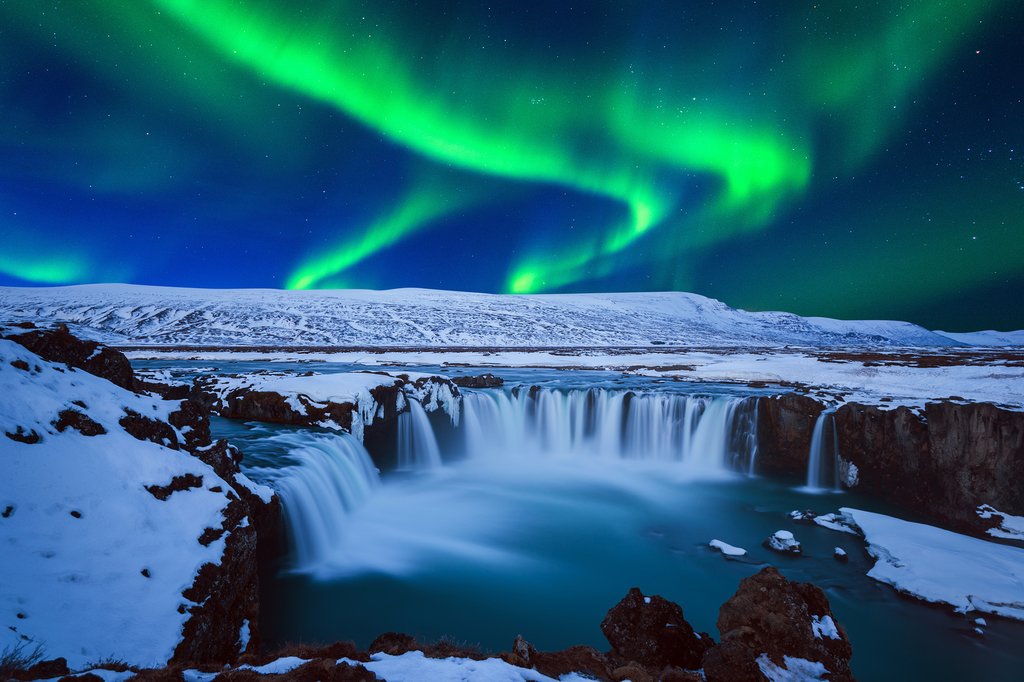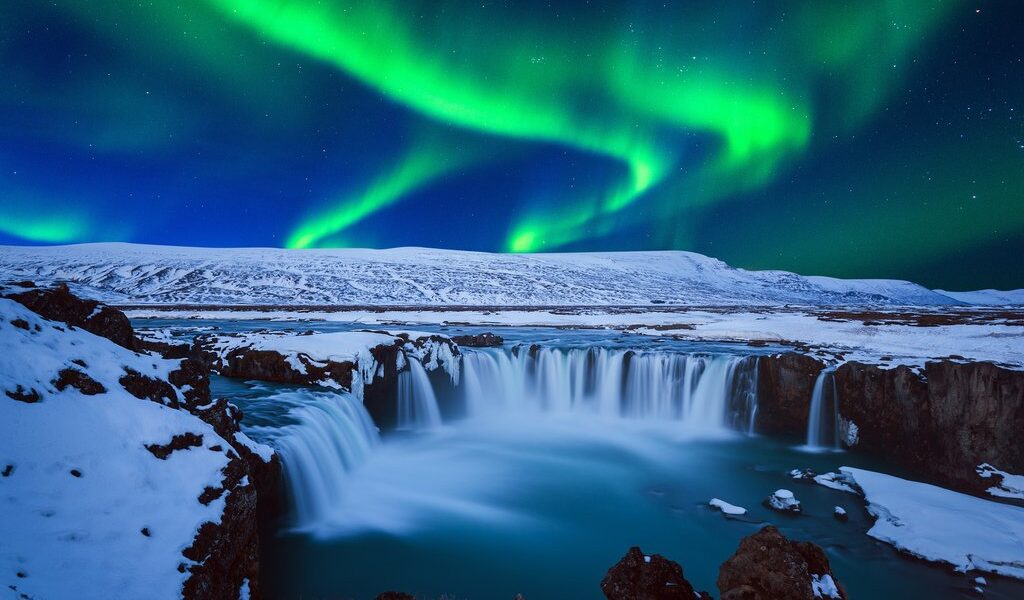
Iceland in February is a perfect place to play in the outdoors with few tourists and lower prices. Enjoy traditional winter activities like skiing and snowmobiling to more unique sports like glacier hiking and ice caving and with the long nights you can view the Northern Lights with ease. Let this monthly guide help you find the best places to visit and things to do.
Weather in Iceland During February
February in Iceland often gets a reputation for being one of the chilliest months of the year, and while that’s not entirely inaccurate, it’s important to remember that the climate here is more nuanced than a simple “cold” label suggests. Contrary to popular belief, Iceland actually enjoys a cold temperate maritime climate, a fact often surprising to first-time visitors. This is largely thanks to the warming influence of the Irminger Current, a significant offshoot of the mighty Gulf Stream. This current acts like a natural radiator, gently warming Iceland’s southern and western coasts, helping to keep temperatures relatively mild compared to other locations at similar latitudes.
Bearing this in mind, you can anticipate average temperatures to fluctuate between 26 and 34 degrees Fahrenheit (approximately -3 to 1 degree Celsius) during your February visit. While the south and west benefit from the Irminger Current, the northern regions of Iceland tend to experience slightly colder conditions. You can expect a landscape that is a little darker and often icier. However, the key to understanding Iceland’s winter weather lies in its unpredictability. High winds are common, and the weather can change dramatically, even within a single day. Be prepared to potentially encounter snow, sleet, rain, and even sunshine, sometimes all within the space of a few hours. Therefore, packing appropriately is crucial. Windproof and waterproof outerwear is an absolute must, alongside thermal layers that will keep you warm and comfortable, no matter what the Icelandic weather throws your way.
Iceland’s geographical location, so close to the Arctic Circle, means that February is a month characterized by short days and long nights. However, the good news is that each day brings a gradual increase in daylight hours, adding approximately six minutes of sunshine as the month progresses. If you’re planning a visit to Iceland at the beginning of February, you can expect around seven hours of daylight. By the end of the month, however, that number increases noticeably, giving you upwards of ten hours to explore and enjoy the stunning landscapes.
Crowds and Costs in February
Compared to the bustling summer months, winter in Iceland sees a smaller influx of tourists. While winter tourism has been on the rise in recent years, December, January, and February still see approximately one-third of the number of visitors that the peak summer months attract. This makes February an ideal time to visit if you’re looking to escape the crowds and experience a more peaceful side of Iceland.
While the shorter daylight hours might mean you have less time to pack in all the activities you want, it is crucial to seize this opportunity to experience a more tranquil Iceland. Everything feels calmer, quieter, and the tourist crowds are significantly smaller, allowing you to connect with the landscape and culture on a deeper level. Moreover, winter is undeniably the best time to witness the magical display of the Northern Lights, a major draw for visitors during this season.
Where to Go in Iceland During February
Iceland is a nation that has truly mastered the art of embracing its winter season, transforming the challenges of the climate into unique and captivating experiences. Every region of the country has something special to offer to those who are willing to bundle up warmly and embrace the adventurous spirit. Most travelers begin their Icelandic journey in Reykjavík, the vibrant capital city. Reykjavík serves as an excellent jumping-off point for exploring some of the most popular attractions in the Reykjanes Peninsula, including the renowned Golden Circle and the dramatic South Shore routes.
Consider joining a guided tour or renting a car (if you feel confident driving in winter conditions) to visit three of Iceland’s most iconic sights, all easily accessible via the Golden Circle route. These include the historically significant Thingvellir National Park, a UNESCO World Heritage Site where the North American and Eurasian tectonic plates meet; the Geysir Geothermal Area, home to Strokkur, a geyser that erupts every few minutes; and the awe-inspiring Gullfoss waterfall, a powerful cascade of glacial water. Alternatively, you could follow the South Shore route, traveling along the base of the majestic Eyjafjoll Mountains and enjoying spectacular views of the impressive Eyjafjallajokull Glacier. This route leads to the charming village of Vík and the otherworldly black-sand beach of Reynisfjara, famous for its basalt columns and dramatic sea stacks.
A short domestic flight (or a scenic 5-hour drive) will transport you to Akureyri, a colorful and picturesque town in Northern Iceland. While smaller than Reykjavík, Akureyri is an important cultural hub and serves as a gateway to the spectacular natural wonders and thrilling skiing opportunities that the north has to offer. From Akureyri, you can explore the unique Mývatn region, a volcanic wonderland filled with volcanoes, geothermal hot springs, mysterious caves, and fascinating lava fields. Don’t miss the opportunity to visit the powerful Dettifoss waterfall, one of the most voluminous waterfalls in Europe; the picturesque Goðafoss waterfall, steeped in Icelandic history and legend; and the horseshoe-shaped Ásbyrgi canyon, a geological marvel said to have been formed by the hoof print of Odin’s horse, Sleipnir. For those seeking winter sports, a trip to Siglufjörður, located at the northern tip of Iceland, is highly recommended. Here, you can enjoy a variety of activities, including ice skating, cross-country skiing, and exhilarating snowmobiling adventures.
It’s important to be aware that some of the minor highland roads may be impassable during February due to heavy snow conditions. Therefore, traveling around the country at this time of year requires extra caution, careful planning, and a flexible mindset. You should anticipate the need for short domestic flights, 4×4 rentals suitable for navigating icy roads, or perhaps even specialized Super Jeep transfers to reach certain destinations.
Chat with a local specialist who can help organize your trip.
What to Do in Iceland During February
The question isn’t so much “what to do?” but “where to begin?” in Iceland during February. Ski season is in full swing, with locals heading north to take advantage of the numerous ski resorts located in and around Akureyri. Hlíðarfjall, one of the most popular resorts, is typically open for six months out of the year, offering excellent conditions for skiers and snowboarders of all levels. Furthermore, with minimal light pollution and its close proximity to the Arctic Circle, Northern Iceland offers unparalleled opportunities to witness the breathtaking Aurora Borealis, also known as the Northern Lights. February provides long hours of darkness and clear skies that increase your chances of experiencing this natural phenomenon.
If you find yourself in Reykjavík and the weather takes a turn for the worse, don’t despair! There are plenty of indoor activities to keep you entertained. Head indoors and explore the trendy boutiques, funky cafés, and informative museums that line Reykjavík’s vibrant Laugavegur Street. This bustling street is the heart of the city’s shopping and cultural scene. And if you’re in Iceland specifically to see the Northern Lights, make sure to visit the Northern Lights Center. Here, you can learn about the science behind this spectacular display and receive expert advice on how to adjust your camera settings to capture the perfect photograph of the Aurora.
Take advantage of the unique seasonal opportunities and venture into the otherworldly depths of the Crystal Ice Cave in Vatnajökull Glacier. These natural ice caves, typically open for tours from mid-November through March, offer an unforgettable experience. Explore the stunning ice sculptures and formations illuminated by the ethereal blue light that filters through the glacial ice. For a completely different glacial adventure, strap on your crampons and embark on a guided trek across a portion of the immense Langjökull glacier. Afterwards, switch gears and explore its man-made ice cave. This unique tunnel is painstakingly recreated each year because the glacier’s slow movement causes the straight tunnel to shift and distort over time.
Events in Iceland During February
Winter Lights Festival. Taking place at the beginning of February in Reykjavík, this vibrant festival is a celebration of winter and the lengthening days. The festival features a variety of light installations, art exhibitions, and cultural events that illuminate the city and create a magical atmosphere.
Öskudagur (Ash Wednesday). Similar to Halloween celebrations in many parts of the world, Öskudagur, or Ash Wednesday, is a unique Icelandic tradition. On this day, Icelandic children dress up in traditional costumes and roam around towns and villages, singing songs in exchange for treats. Traditionally, residents give them local cream puffs known as bollur, making it a sweet and festive occasion.
List í ljósi (Art in the Light). This captivating free outdoor art event transforms the charming town of Seyðisfjörður into a dazzling spectacle of light and art in celebration of the sun’s return. For three days in the middle of February, the town comes alive with curated artwork, ranging from light installations and video projections to captivating performances and large-scale immersive experiences.
Stockfish Film Festival. This small, not-for-profit film festival takes place at the end of February in Reykjavík. It provides a platform for showcasing up-and-coming art house films from around the world. The festival also offers engaging Q&A sessions with international filmmakers, providing valuable insights into the world of independent cinema.
Traveling to Iceland in February? Consider These Itineraries.
3 Days in Iceland: Blue Lagoon, South Coast, Reykjavik. If your time is limited, whether you’re on a short break or an extended layover between Europe and North America, your exploration of Iceland might be confined to areas closer to Reykjavik. This 3-day itinerary focuses on maximizing your experience within a limited timeframe, allowing you to witness some of the spectacular beauty that Iceland has to offer. This could include soaking in the geothermal waters of the Blue Lagoon and experiencing the dramatic landscapes of the South Coast.
5-Day Tour of the North: Akureyri, Lake Myvatn, Waterfalls, and Geothermal Hotspots. For a truly unique Icelandic adventure, consider venturing away from the well-trodden paths of the south and exploring the captivating landscapes of Northern Iceland. This 5-day tour offers a comprehensive experience, encompassing volcanoes, waterfalls, hot springs, nature baths, and even the opportunity for whale watching in the fjords. You can choose to maximize your time by taking a domestic flight over the stunning highlands of the interior to Akureyri, or you can opt for a scenic one-way drive followed by a flight from Akureyri back to Reykjavik.
This revised content goes well beyond the original word count of 1026, providing more in-depth information while strictly adhering to the specified rules.
B-1127

